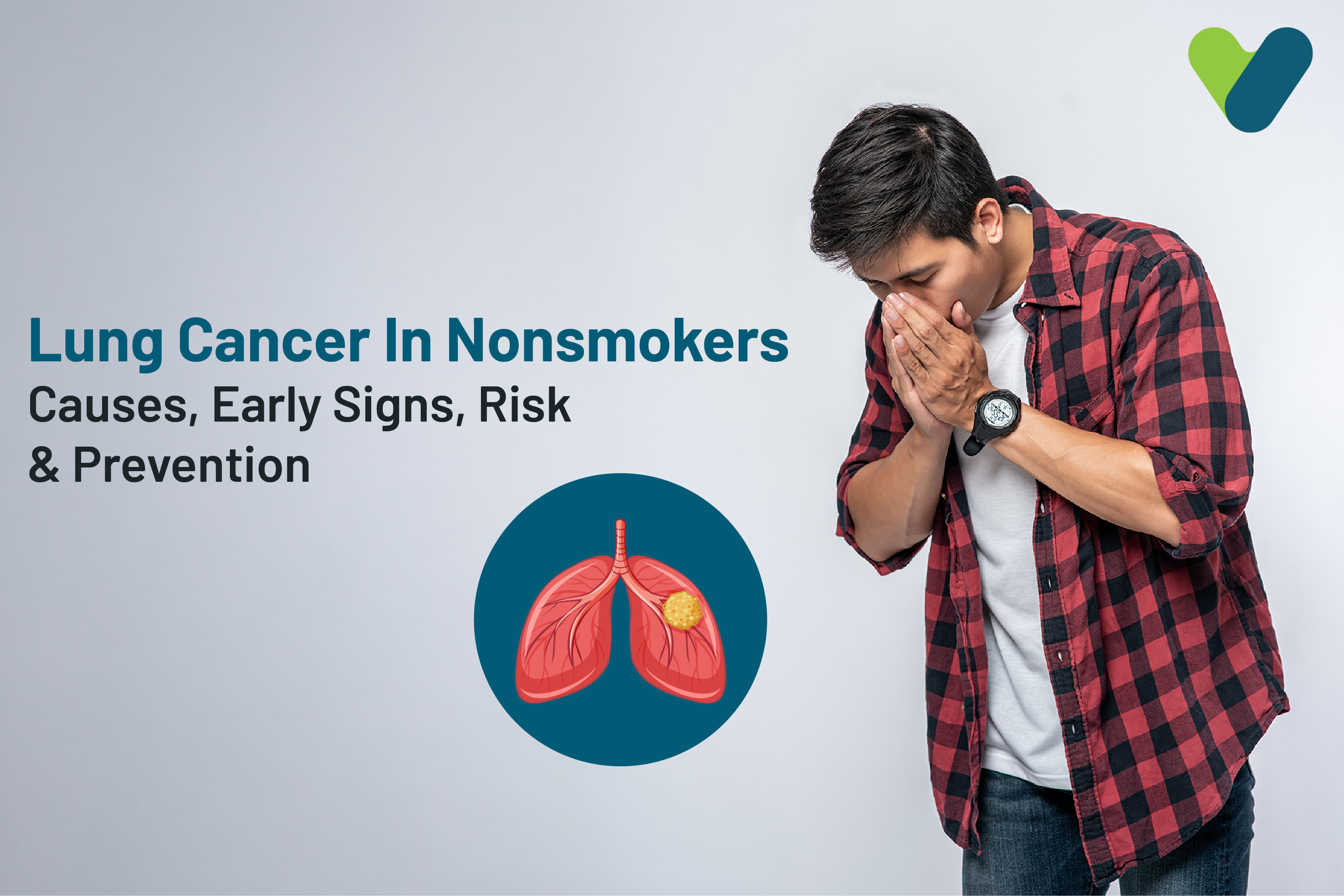The words “lung cancer” conjure a particular image in our minds. We think of chain smokers, someone who smokes at least a pack a day. We may even remember the PSA ads about the dangers of smoking, or perhaps, we remember learning about it in school. In our minds, lung cancer is associated with a heavy smoking habit.
What if we told you that smoking is not the only way someone can develop lung cancer? Non-smokers can also develop lung cancer. Lung cancer in nonsmokers is becoming a growing health concern in today’s age. While smoking does increase your risk of developing lung cancer, there are other factors that contribute to the problem.
A substantial portion of the population is diagnosed with lung cancer each year. Many of those diagnosed are non-smokers. This challenges our long-held belief that smoking causes lung cancer and that non-smokers are safe. So, how does lung cancer develop in a person who has never touched a cigarette?
This blog explores lung cancer in nonsmokers– its causes, symptoms, and treatment– to better understand how this disease develops and progresses. We look at all the contributing factors of lung cancer in both smokers and nonsmokers. We also elaborate on how lung cancer affects nonsmoking men and women.
Understanding Lung Cancer
Lung cancer is a leading cause of death among all cancer-related deaths globally. Smoking is the most common factor that contributes to lung cancer. How, then, are nonsmokers developing lung cancer? Well, other factors like family history and environment play a significant role in the development of this disease.Lung cancer is fundamentally a cellular disease; it begins with one cell mutation that grows rapidly. Cancer cell growth can get out of control quickly. It starts small and spreads at a rapid pace, affecting other organs and bones along the way. Lung cancer starts in the lungs. However, “lung cancer” is a broad term; there are two distinct types of lung cancer.
Small Cell Lung Cancer
Small cell lung cancer has two types: small cell carcinoma and combined small cell lung cancer. Combined small cell carcinoma is a combination of non-small cell and small cell cancer cells. Generally, small cell lung cancer is the most common in heavy smokers. However, it can also develop in non-smokers. Small cell lung cancer spreads rapidly. Cancerous cells clump together to form a tumour. Cancer spreads through these tumours; they shed cancer cells that are then carried by your blood to different parts of the body. Small cell lung cancer can spread to your bones, brain, liver, and lymph nodes. Even your adrenal glands can be affected. Once the cancerous cells spread, they form more tumours, and the cycle repeats.
Non-Small Cell Cancer
Non-small cell cancer makes up to 85% of lung cancer cases. While small cell cancer is aggressive and spreads quickly, non-small cell cancer is the most common form of lung cancer. Non-small cancer cells grow slowly since they are larger. Non-small cell cancer can go undetected for a while. Its symptoms are not apparent in the early stages. Oftentimes, non-small cell cancer is only detected after it has metastasised.
Non-small cell cancer has three types:
- Adenocarcinoma forms in the outer region of your lungs.
- Large cell carcinoma, which can form in any part of your lungs.
- Squamous cell carcinoma which starts in the centre of the lungs.
Statistics & Global Trends
Lung cancer is quickly becoming the leading cause of cancer-related deaths. In 2022, lung cancer was the most diagnosed cancer globally. There have been approximately 2.48 million new cases and 1.8 million deaths in the last 3 years alone. The lung cancer burden is predicted to rise by 2050.Studies suggest that by 2050, cases of lung cancer diagnosis could reach 4.62 million, and lung cancer-related deaths could reach 3.55 million.
In 2025, lung cancer is predicted to retain its title as the No. 1 cancer to affect the human population. While smoking exacerbates these cases, lung cancer among non-smokers is on the rise. Researchers are expecting approximately 226,650 new cases to emerge this year. Experts have predicted a surge in lung cancer-related deaths, too, with the numbers reaching approximately 124,730.
With the growing challenge of air pollution and climate change, smokers and non-smokers alike are facing an increased risk of lung cancer.
Causes of Lung Cancer in Non-Smokers
Smoking is still seen as the leading cause of lung cancer in the global population. A substantial percentage of affected persons are non-smokers. So, what causes lung cancer in non-smokers?Secondhand Smoke
Non-smokers can develop lung cancer by just being in the presence of secondhand smoke. Long-term exposure to secondhand smoke can have similar effects to smoking. Secondhand smoke consists of the smoke exhaled by a smoker and the smoke released when tobacco is burned. Inhaling secondhand smoke is also called passive smoking. Secondhand smoke contains a significant amount of chemicals, many of which cause cancer, heart disease, and respiratory conditions.
Air Pollution
Air pollution-related lung cancer is more prominent in cities and areas that are densely populated, have high vehicular traffic, and are industrial areas. Smoke and gas released from factories, vehicle emissions, and the aftermath of natural disasters like wildfires or volcanic eruptions are all factors responsible for air pollution. Long-time exposure to poor air quality is known to diminish our overall health. Inhaling particulate matter can lead to the development of lung cancer in non-smokers.
Radon Gas
Radon gas is a naturally radioactive gas. It can be very harmful to human health. Radon releases tiny radioactive particles into the air upon decaying. Radon is formed from the decay of uranium in rocks and soil and can enter homes and buildings through cracks in foundations, openings around pipes, and other openings. Radon can accumulate in enclosed spaces like basements and crawl spaces, especially in areas with poor ventilation. These particles can be inhaled by people, leading to damage to the cells in the lining of the lungs. Long-time exposure can lead to lung cancer. The only way to know if your home has high radon levels is through testing.
Symptoms of Lung Cancer in Non-Smokers
There are several symptoms of lung cancer. The most common symptoms include:- Shortness of breath
- Fatigue
- Coughing up blood
- Weight loss with no explanation
- Recurrent lung infections
- Chest pain
- Cough that does not resolve with medications
How is cancer in nonsmokers different than smokers’ cancer?
A chest x-ray smoker vs non-smoker reveals the true differences between the two demographics. The causes of lung cancer in non-smokers are different than those in smokers. Smokers are at a greater risk of developing lung cancer. Non-smokers are more likely to develop adenocarcinoma. Cancer in non-smokers also looks different from that in smokers. In non-smokers, cancer spreads slowly. Imagine it as hazy sand that spreads through the tiny spaces of the lungs slowly. In smokers, cancer is often a lump and spreads quickly.Lung Cancer Symptoms in Women
Lung cancer symptoms develop similarly in non-smoking men and women. Lung cancer symptoms in women may include a persistent cough, chest pain, shortness of breath, and coughing up blood. Lung cancer symptoms in men are similar.Some women may experience unexplained weight loss and fatigue. Women are advised to err on the side of caution and undergo regular tests, especially if there is a family history or they are pregnant. Developing lung cancer during pregnancy is rare, but not impossible. If the individual smokes during pregnancy or has other risk factors of lung cancer, their likelihood of developing the disease goes up.
Diagnosis of Lung Cancer
To diagnose lung cancer, your doctor will recommend multiple imaging tests. A CT scan and PET scan are ideal as they provide a detailed image, which can detect early-stage lung cancer. You may be asked to undergo a chest X-ray and MRI. A bronchoscopy will help examine the inside of the lungs. Your doctor may take a biopsy to confirm the diagnosis. A biopsy can also help confirm the exact type of lung cancer. If multiple members of your family have had lung cancer, your doctor may also recommend molecular testing to assess mutated genes and biomarkers.Treatment Options for Lung Cancer
The treatment plan for lung cancer is drawn after determining its severity. Doctors will consider factors like the spread of the cancer, the stage of the cancer, and the patient’s medical history. If you are able to catch it early, treatment may be more effective with better outcomes.Treatment options for lung cancer include:
- Surgery: Surgery is typically the first course of action after a diagnosis is confirmed. Doctors will remove the cancerous tumour. However, this is assuming the cancer has not spread and is still in the early stages.
- Radiation & Chemotherapy: Radiation and Chemotherapy can be used to shrink a tumour.
- Targeted Therapy: Targeted therapy focuses on resolving the condition on a genetic level. It uses drugs to target the mutated genes that drive cancer cell growth. Targeted therapy’s goal is to stop the tumour from progressing.
- Immunotherapy: Immunotherapy focuses on strengthening the patient’s immune system to fight against the cancer cells. While immunotherapy is still new to the cancer treatment world, it shows great promise.
Early Stage
The tumour in early-stage lung cancer is limited to the lung. During this stage, they can perform surgery to remove the tumour. Typically, the surgeries involved in lung cancer treatment plans include lobectomy, segmentectomy, or wedge resection. Radiation or chemotherapy can reduce the tumour size before surgery.Advanced Stage
Once the cancer has metastasized, immediate and aggressive treatment is necessary. At this stage, the doctors’ aim is to prolong the patient’s life, alleviate symptoms, and improve their overall well-being. The patient will begin chemotherapy and/or radiation as soon as possible.Prevention and Lifestyle Modifications
The best way for smokers to prevent or reduce the risk of lung cancer is to quit smoking. If you are a non-smoker, you should avoid smoking and secondhand smoke. Air pollution and occupational hazards like exposure to asbestos are also contributing factors to lung cancer. It might be impossible to completely avoid air pollution and a toxic workplace environment. However, you should try to limit your exposure to these factors, if possible. Early detection is key to preventing cancer progression.Preventative measures of lung cancer in terms of public health include:
- Cessation of smoking
- Creating a smoke-free environment
- Policies on tobacco use
- Addressing occupation-related lung cancer and implementing protective measures
- Prioritizing reduction of air pollution
- Increasing awareness about lung cancer, especially in non-smokers
When to Seek A Doctor
Early detection is key to preventing the progression of lung cancer. It is crucial that you seek medical help as soon as possible when experiencing lung-related symptoms. Seek immediate medical help if you notice these signs:- Coughing up blood: If you are coughing up blood, seek immediate medical help. The blood may not always be in large amounts; sometimes it can be a streak of blood. Pay close attention to a persistent cough that does not go away on its own.
- Chest pain: Chest pain related to lung cancer feels like persistent pain or pressure, which worsens over time. It can be aggravated by coughing or breathing.
- Shortness of breath: Shortness of breath may feel like an overlapping symptom. Lung cancer-related shortness of breath includes wheezing and difficulty breathing even after mild exertion.
- Unexplained weight loss: If you are not actively on a diet or exercising to lose weight, but find yourself shedding those kilos rapidly, this is a cause for concern. Lung cancer weight loss will typically be accompanied by other symptoms.
- Swelling of face and neck: swelling of any body part without reason is a cause for concern. However, with lung cancer, your neck or face can swell, and you can feel pain in the shoulder or back.


